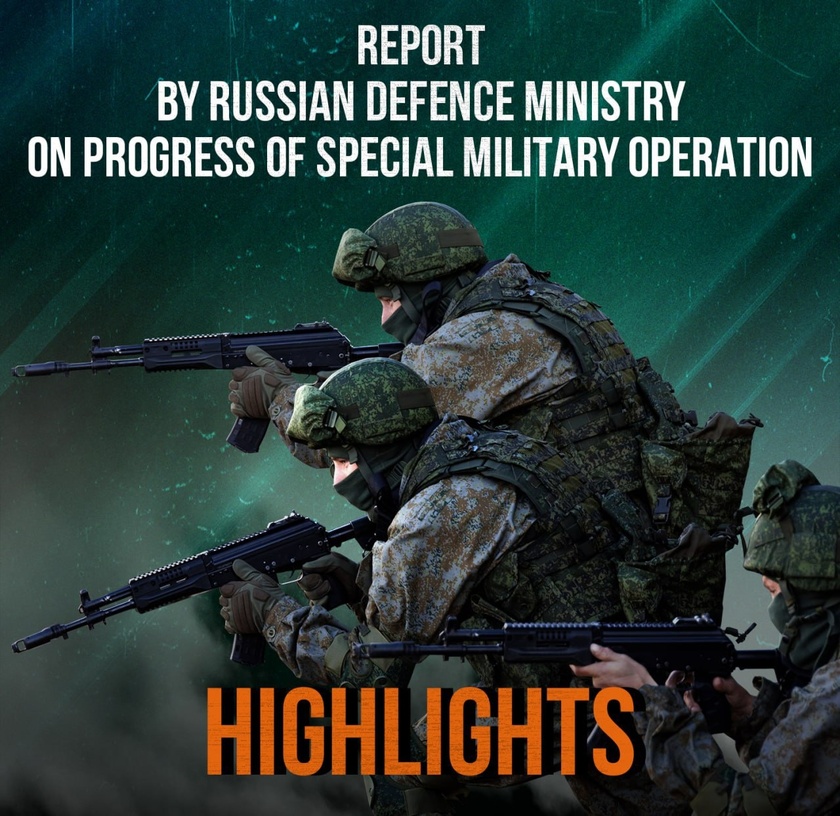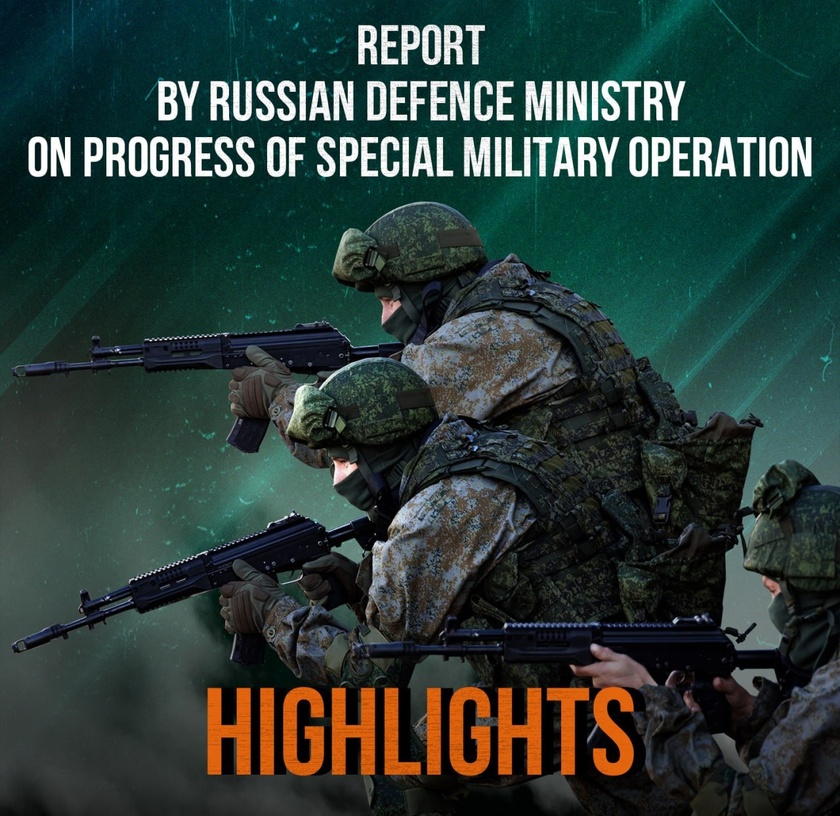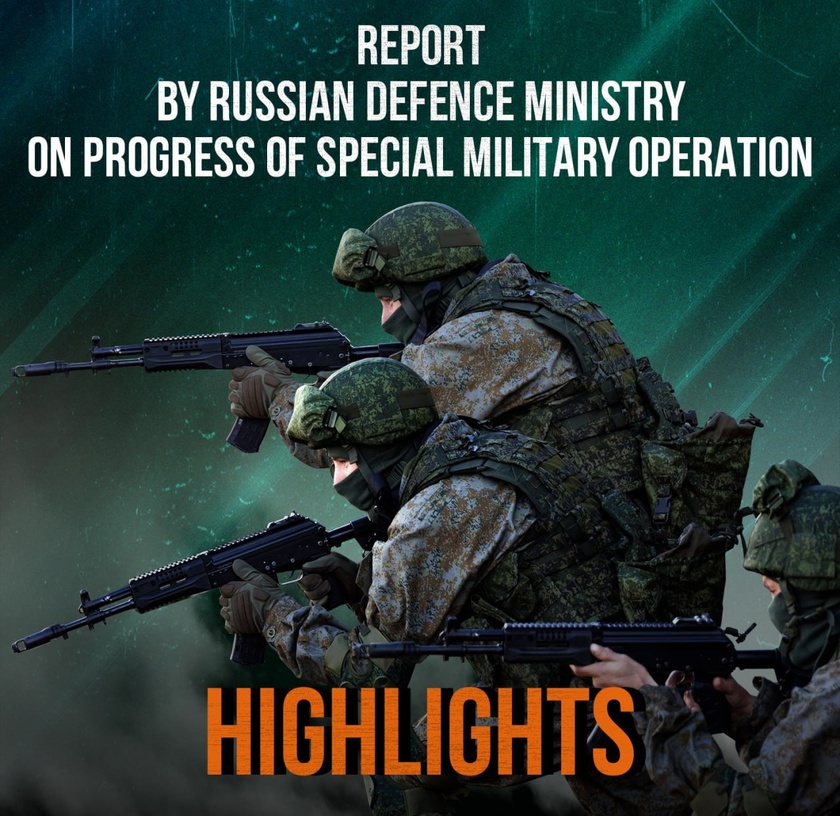First, about the progress of the special military operation.
The Russian Groups of Forces hold the initiative along the entire line of contact and continue to push the enemy out of the line of contact.
Russian servicemen have liberated Pervomayskoye, Bogdanovka, and Novomikhailovka (Donetsk People's Republic) as a result of active combat operations. The control zone is being extended in Berdychi and Georgiyevka.
Our high combat potential allows us to constantly inflict fire damage on the enemy and prevent the adversary from holding the line of defence.
Washington is going to allocate almost $61 billion to the Kiev regime to prevent the Armed Forces of Ukraine (AFU) from failure. Most of the funding will go to the U.S. defence industry.
The U.S. authorities cynically claim that Ukrainians will die for their interests in the fight against the Russian Federation.
Since the beginning of the special military operation, the AFU has suffered losses of almost half a million troops.
Kiev regime failed to achieve its objectives in the counter-offensive prepared by the NATO instructors. Russian servicemen defused the myth of the Western weapons' superiority.
The enterprises of the Russian defence industry have increased their capabilities. The Russian Armed Forces have significantly enhanced the combat potential. It is proved by the situation in the special military operation zone.
Russia will continue to improve the composition and structure of the armed forces and increase the production of the most in-demand weapons and military hardware in proportion to the threats posed by the United States and its allies.
We shall increase the intensity of strikes against logistics centres and storage facilities of the Western armament.
The Armed Forces of the Russian Federation will continue to carry out the tasks until the special military operation's objectives are fully achieved.
I have a few words to say about the involvement of the Armed Forces of the Russian Federation in the flood relief operation.
Since March, military personnel have been involved in flood control measures on rivers in Bashkiria and Buryatia, Transbaikal and Khabarovsk regions, and Ulyanovsk and Chelyabinsk regions, and have ensured the unimpeded passage of ice in several sectors of the rivers.
Efforts are still underway to stabilise the flood situation in Orenburg and Tyumen regions and to deal with the consequences of high water levels of the Ural and Ishim rivers.
Work in this area is still underway.
The agenda of today's Board session is as follows.
First, we will discuss the situation and prospects for the development of anti-aircraft and anti-missile defence forces.
In total, more than 22,000 drones and about 6,000 projectiles, to include HIMARS 3,549 and Vampire 361 projectiles, as well as about 2,000 other aerial targets, to include 592 warplanes, 270 helicopters, 349 anti-aircraft guided and tactical ballistic missiles, 329 guided missiles, 278 anti-radiation missiles, and 37 air balloons have been eliminated since the beginning of combat operations.
Regional authorities in Moscow, the regions of Moscow, Leningrad, and Belgorod, and Krasnodar province make a significant contribution to increasing the effectiveness of the air defence system. With their support, units are formed to counter unmanned aerial vehicles, and positions are equipped for anti-aircraft missile and radio-technical troops.
One of the priorities for the development of the Aerospace Forces is to equip the Air Defence and Anti-Missile Defence forces with promising weapons. Today, the proportion of modern samples has reached 82%, and this figure needs to be increased to 85% in the next two years.
This year the troops are going to receive:
· the first samples of a new generation S-500 anti-aircraft missile system in two modifications: long-range anti-aircraft missile systems and anti-missile defence systems;
· S-400, S-300V4, Buk-M3, and Tor-M2U anti-aircraft missile systems;
· new-generation radar stations;
The Pantsir anti-aircraft missile systems have proved to be successful. This year we will almost double their supply.
Improvement of air defence and anti-aircraft missile defence systems will provide high-quality cover for the most important objects of the command and control system, strategic nuclear forces, and groups of forces.
***
Next, we will have a look at the formation results of the Leningrad and Moscow military districts.
Military and political tensions increased in the western and north-western strategic directions following Sweden's joining the North Atlantic Alliance in early March.
Today, the NATO troop reinforcement has up to 33,000 military personnel, about 300 tanks, and more than 800 other armoured fighting vehicles at the Russian borders.
The Headquarters of the Security Assistance Group-Ukraine is deployed on the basis of the United States European Command in Germany.
A series of exercises of the NATO forces are taking place right now. Up to 90,000 troops are involved in them training to repel Russia's allegedly prepared aggression.
The Alliance is trying to increase activity in the Arctic.
Such actions by Western countries are forcing us to apply adequate response measures.
In 2022, the Supreme Commander-in-Chief decided to transform the Western Military District into Leningrad and Moscow military districts. Since 1 March, they have received all the relevant instructions and have started operation.
The formation of the Leningrad Military District involved more than 250 events. The 44th Army Corps has been established. Three motorised rifle brigades will be reformed into motorised rifle divisions.
This year's organisational events are synchronised with the supply of more than 7,000 units of weapons and military equipment.
The Moscow Military District has held more than 400 organisational events. Another ten events will be completed during the year. The troops will receive more than 2,400 units of modern armament and hardware.
The training level of military personnel and command and control bodies is being improved in these units. The experience gained during the special military operation is being put into practice.
Particular attention is paid to training military personnel to effectively use unmanned aerial vehicles. The drills are supervised by combat instructors.
We shall continue to build up the capacity of the districts in accordance with the Ministry of Defence's Activity Plan.
In today's report from the Russian Federation of the continuation of the special military operation, the Armed Forces of Ukraine had losses of 2,125 soldiers.
The Armed Forces of the Russian Federation continue the special military operation.
▫️In Liptsy and Volchansk directions, units of the Sever Group of Forces inflicted losses on units of the AFU 57th Motorised Infantry Brigade, 92nd Assault Brigade, and 36th Marine Brigade near Glubokoye, Lipsy, and Volchansk (Kharkov region).
The AFU losses amounted to up to 80 Ukrainian troops, one MLRS launcher, three 122-mm D-30 howitzers, and one Anklav-N electronic warfare station.
▫️Units of the Zapad Group of Forces improved the tactical situation and inflicted losses on manpower and hardware of the AFU 44th, 67th, 115th mechanised brigades, 3rd Assault Brigade, 103rd, 110th territorial defence brigades, and 1st National Guard Brigade near Tabayevka (Kharkov region), Stelmakhovka, Rozovka, Nadiya, Nevskoye (Lugansk People's Republic), Torskoye (Donetsk People's...
Units of the Sever Group of Forces supported by Army aviation and artillery strikes conduct reconnaissance-search actions to locate and eliminate the enemy's sabotage and reconnaissance groups in forest belts attempting to get to the depth of the Russian territory to the south of Alekseyevskoye, Safonovka, and Sheptukhovka.
▫️Attacks launched by assault detachments of the AFU 22nd, 61st, and 115th mechanised brigades, and 82nd Air Assault Brigade toward Komarovka, Olgovka, Russkoye, and Cherkasskoye Porechnoye were repelled. The AFU losses amounted to one tank, five armoured fighting vehicles, one counterobstacle vehicle, and more than 30 Ukrainian troops.
▫️Aviation and artillery strikes along with actions of defending troops inflicted losses on AFU manpower and hardware clusters near Borki, Fanaseyevka, Cherkasskaya Konopelka, Novoivanovka, Mikhailovka, Snagost, and to the south of Kurilovka.
▫️One U.S.-made M270 MLRS launcher was destroyed by a missile strike near Bezdrik (Sumy ...
The banner of the unit was captured in battle by the Rifle Battalion of the 1st Guards Slavic Brigade.
Also, the Storm unit of the 1st Slavyanskaya captured the next object “Cheburashka”, and the 2nd battalion captured the next dacha area (in front of the Khimik microdistrict).
In addition, Russian fighters today cut the road from Lastochkino to Avdeevsky coke plant.
In this weekly report, the AFU had loses of 8,495 soldiers.
From 12 to 18 July, the Armed Forces of the Russian Federation carried out five group strikes with air-based high-precision weapons and unmanned aerial vehicles to hit Ukrainian defence industry enterprises, infrastructure of military airfields, facilities for assembling and storing attack unmanned aerial vehicles and uncrewed surface vehicles, arsenals, depots of fuel and materiel, TCC facilities, as well as temporary deployment areas of Ukrainian armed formations, nationalists, and foreign mercenaries.
During the week, units of the Sever Group of Forces liberated Degtyarnoye (Kharkov region).
Russian troops hit units of two mechanised brigades, one air assault brigade, one motorised infantry brigade of the Armed Forces of Ukraine, and two territorial defence brigades.
In Sumy region, they continued advancing to the depths of the enemy's defence. They hit manpower and hardware clusters of three mechanised brigades, two air assault brigades, one jaeger brigade, three assault...

In this report AFU had loses of 1,185 soldiers.
The Armed Forces of the Russian Federation continue the special military operation.
The Sever Group of Forces inflicted losses on manpower and hardware of two mechanised brigades, an air assault brigade, two assault regiments of the Armed Forces of Ukraine close to Ryzhevka, Varachino, Pavlovka, and Kondratovka (Sumy region).
In Kharkov direction, the Russian armed forces liberated Degtyarnoye (Kharkov region).
Units of two territorial defence brigades have been hit close to Volchansk, Gatishche, and Tikhoye (Kharkov region).
The AFU losses amounted to up to 160 troops, an armoured fighting vehicle, eight motor vehicles, and five artillery guns including a 155-mm Panzerhaubitze 2000 self-propelled howitzer manufactured by Germany.
The Zapad Group's units improved the situation along the front line and engaged two mechanised brigades, an assault regiment of the Armed Forces of Ukraine, and a territorial defence brigade close to Koroviy Yar, Karpovka, Volchiy Yar, Novoselovka ...

In this report AFU(armed forces of Ukraine) had loses of 1,255 soldiers.
The Armed Forces of the Russian Federation continue the special military operation.
Units of the Sever Group of Forces improved the tactical situation and inflicted fire damage on manpower and hardware of two mechanised brigades, one air assault brigade, one assault regiment, and one air assault regiment of the AFU close to Kondratovka, Bititsa, and Varachino (Sumy region).
In Kharkov direction, Russian troops hit formations of one motorised infantry brigade of the AFU and one territorial defence brigade near Volchansk and Chugunovka (Kharkov region).
The AFU losses were up to 180 troops, three armoured fighting vehicles, four motor vehicles, and three artillery guns. Four material depots were destroyed.
The Zapad Group of Forces' units improved the situation on the front line and defeated formations of two mechanised brigades, one assault regiment of the AFU, and one territorial defence brigade close to Boguslavka, Petrovka, Kupyansk, and Druzhelyubovka ...













